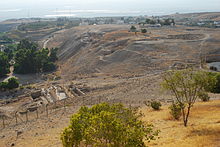Battle of Fahl
This article needs additional citations for verification. (October 2021) |
Coordinates: 32°27′N 35°37′E / 32.450°N 35.617°E
| Battle of Fahl | |||||||
|---|---|---|---|---|---|---|---|
| Part of the Arab–Byzantine Wars and the campaigns of Khalid ibn al-Walid | |||||||
 Pella ( Tabaqat Fahil ): overview of the site | |||||||
| |||||||
| Belligerents | |||||||
| Rashidun Caliphate |
| ||||||
| Commanders and leaders | |||||||
|
Khalid ibn al-Walid Shurahbil bin Hassana | Theodore the Sacellarius | ||||||
| Strength | |||||||
| Unknown | Unknown | ||||||
| Casualties and losses | |||||||
| Heavy[2] | |||||||
The Battle of Fahl, Battle of Pella or Battle of the Mud Arabic: معركة فحل[3] was an Arab–Byzantine battle fought between the Rashidun army under Khalid ibn al-Walid Saifullah (meaning: The Sword of Allah) and the East Roman Empire under Theodore the Sacellarius (Saqalar), in Fahl (ancient Pella along the Jordan Valley of Jordan) in January 635 AD (13 AH).
Battle[]
According to Tabari, the battle at pella field lasts for two days for both days and nights.[2] The imperial army finally broke in the last day and fleeing towards a muddy and watery fields, where the caliphate soldiers give pursuit and cut down the Byzantine soldiers entrapped in the mud, causing them to suffer more greater losses.[2] The result was a clear victory for Khalid ibn al-Walid.[2]
Aftermath[]
As the Imperial forces are destroyed in Fahl Some Byzantine soldiers fled to Beisan. Not long after that, the Corps of Sharhabeel ibn Hasana and 'Amr ibn al-'As pursued them later captured the fortress of Beisan.
The result of this battle significantly reduced the capacity of Byzantine army to operate in southern Syria, as historian Ross Burns said in his book, the massive losses from this battle and the Battle of Ajnadayn practically wiped out the "southern Damascus shield", an Imperial main forces protected the southern Syria.[4] This caused Heraclius to gather two cavalry forces under the lead of Theodore the Patricius, and Shannash al-Rome/al-Rum in a last attempt to retake Damascus.[5][6] However, this cavalry forces are intercepted by Khalid and Abu Ubaidah ibn al-Jarrah in the Battle of Marj ar-Rum and all of Byzantine commanders fallen in the battle, while their soldiers annihilated[5][6]
Aside from the occupation of the area by the caliphate, the recent 20th century archeological study report in 1982 suggested that there are decrease of human habitation of the area during the early caliphate conquests, while there is a n increase of stabling animals in the area.[7] This is suggested by the archeologists involved in the excavation, that there are radical change in the community of Pella, where the semi-sendentary Syrian community from Byzantine era now has been occupied by the semi pastoral people who favor greatly in livestocks and herdings.[7]
References[]
- ^ Historical Photography of Holy sites in Jordan Published by TURAB (owned by The Royal Aal Al-Bayt Institute for Islamic Thought) Photography [Islamic Sites]: Fakhry Malkawi Photography [Christian Sites]: Father Michele Piccirillo and Dino Politis Cover photogragh: Ammar Khammash Text [Islamic Sites]: Sheikh Hassan Saqaf Fatwa on visiting Sacred Sites: Sheikh Hassan Saqaf (Trans. Ja’far Hassan) Text [Christian Sites]: Father Michele Piccirillo Design and layout: Andrea Atalla and Susan Wood Senior Editor: Ghazi Bin Mohammed
- ^ a b c d Blankinship & Tabari 2015, p. 171].
- ^ Hardy, James (2016). "Battle of Yarmouk: An Analysis of Byzantine Military Failure". History Coperative. History Coperative. Retrieved 15 December 2021.
In addition, the Arab army was able to use their foot and cavalry archers to great effect, placing them in prepared positions, and were thus able to halt the initial Byzantine advance, John Haldon, Warfare, State, and Society in the Byzantine World: 565-1204. Warfare and History. (London: University College London Press, 1999), 215-216; The skill of the Arab cavalry, particularly the horse archers, also gave the Arab army a distinct advantage in terms of their ability to outmaneuver their Byzantine counterparts. The delay between May and August was disastrous for two reasons; first it provided the Arabs with an invaluable respite to regroup and gather reinforcements. Second, the delay wreaked havoc on the overall moral and discipline of the Byzantine troops; the Armenian contingents in particular grew increasingly agitated and mutinous, Jenkins, Romilly. Byzantium: The Imperial Centuries AD 610-1071. Medieval Academy Reprints for Teaching. Toronto: University of Toronto Press, 1987. p 33
- ^ Burns 2007, p. 99.
- ^ a b Tabari 1992, p. 174.
- ^ a b Akram 2006, p. 359-417.
- ^ a b McNicoll & Walmsley 1982, p. 342].
Bibliography[]
- Akram, Agha Ibrahim (2006). The Sword of Allah Khalid Bin Al-Waleed, His Life and Campaigns. Mr. Books. Retrieved 16 October 2021.
- Blankinship, Khalid Yahya; Tabari, Muhammad ibn Jarir (2015). The History of Al-Tabari Vol. 11 The Challenge to the Empires A.D. 633-635/A.H. 12-13 (Khalid Yahya Blankinship English ed.). State university of New York Press. ISBN 9780791496848. Retrieved 23 October 2021.
- Burns, Ross (2007) [2005]. Damascus: A History. Routledge. ISBN 978-1-134-48849-0.
- McNicoll, Anthony; Walmsley, Alan (1982). "Pella/Fahl in Jordan during the Early Islamic Period". Anthony W. McNicoll's research while affiliated with The University of Sydney and other places. Retrieved 23 October 2021.
- Tabari, Muhammad ibn Jarir (1992). The history of at-Tabari Vol. 12 (Yohanan Friedmann ed.). ISBN 9780791407332. Retrieved 18 October 2021.
External links[]
- Battles involving the Byzantine Empire
- Battles of Khalid ibn Walid
- Battles of Abu Ubaidah ibn al-Jarrah
- Battles of the Arab–Byzantine wars
- Battles involving the Rashidun Caliphate
- 635
- 630s in the Byzantine Empire
- Muslim conquest of the Levant
- Medieval Jordan
- Battle stubs
